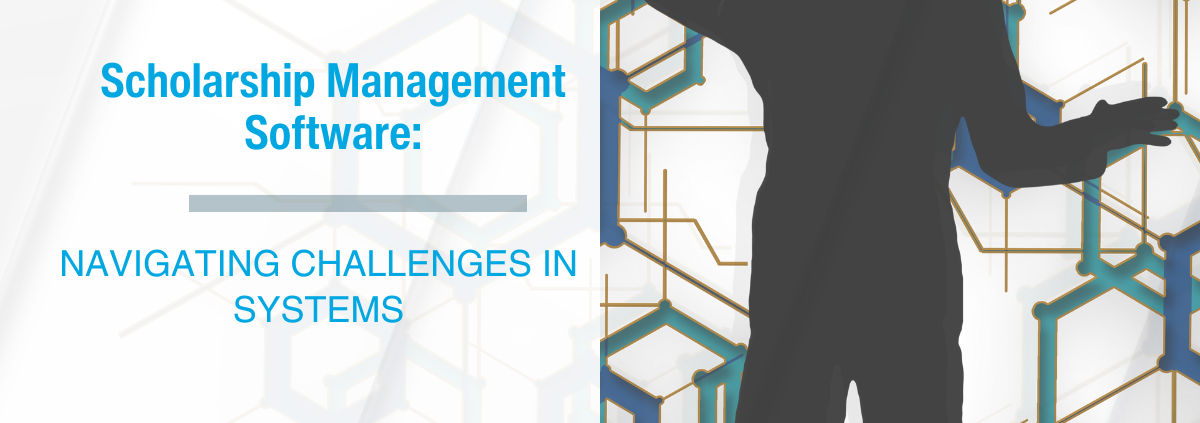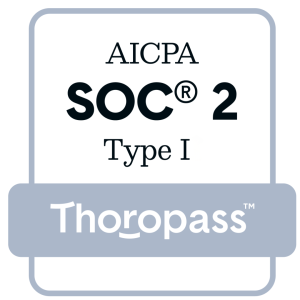Navigating Challenges in Scholarship Management Systems
Table of Contents
- Introduction
- The Evolution of Scholarship Management
- Identifying the Challenges in Scholarship Management
- Overcoming Inefficiency and Outdated Practices
- Ensuring Compliance and Transparency
- Facilitating Remote Work and Data Strategy
- The Role of Scholarship Management Software
- Streamlining Decision-Making and Operations
- Data-Driven Strategies and Analytics
- Enhancing User Experience and Accessibility
- Selecting the Best Scholarship Management Software in the UK
- Addressing the Pain Points of Stakeholders
- The Future of Scholarship Management Systems
- Conclusion: The Strategic Path Forward
Introduction
Navigating the complex landscape of scholarship management can be a daunting task. The challenges are manifold, from ensuring compliance to streamlining decision-making.
Yet, the advent of digital transformation has brought a new dawn. It has opened up a world of possibilities for scholarship management, promising efficiency, transparency, and remote work readiness.
This article aims to guide you through these challenges. It focuses on the best scholarship management software in the UK, a tool that can revolutionize your operations.
Who Needs a Scholarship Management System?
A quick snapshot of the key stakeholders who benefit from streamlining scholarship operations:
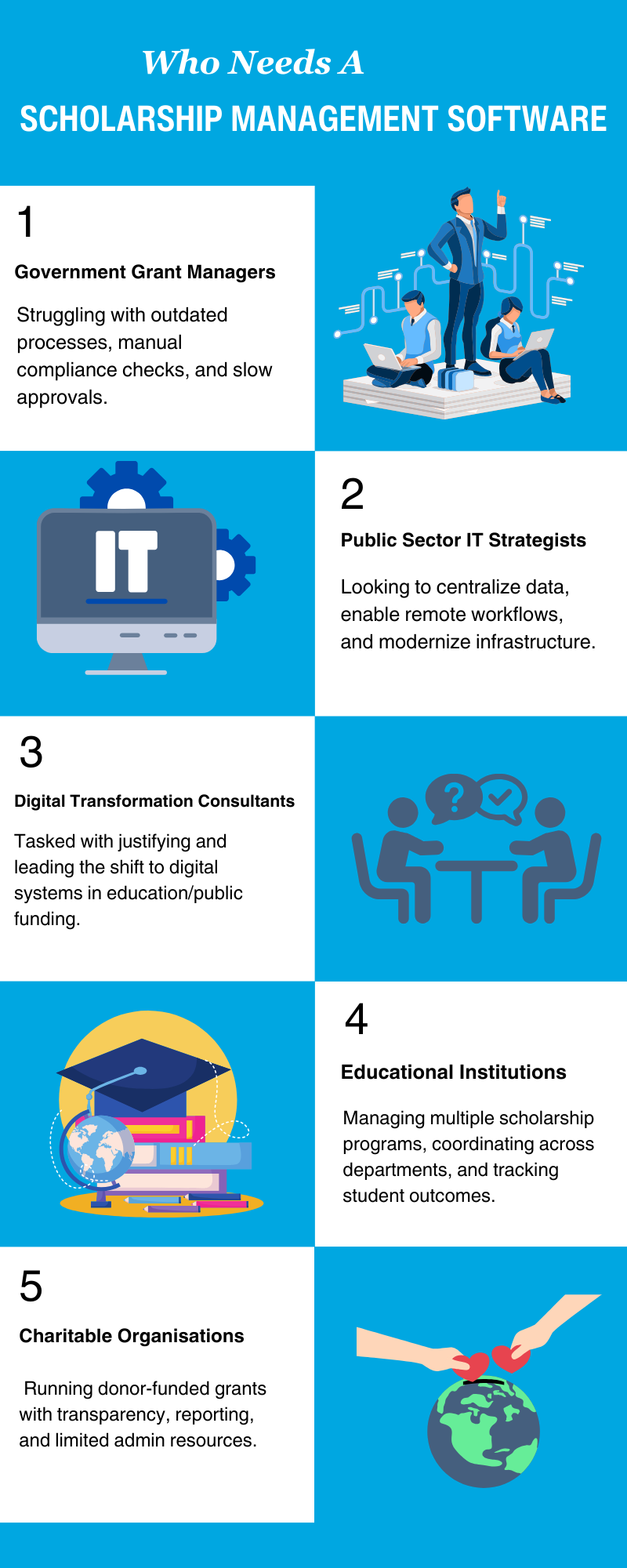
👩💼 Government Grant Managers: Struggling with outdated processes, manual compliance checks, and slow approvals.
👨💻 Public Sector IT Strategists: Looking to centralize data, enable remote workflows, and modernize infrastructure.
🧠 Digital Transformation Consultants: Tasked with justifying and leading the shift to digital systems in education/public funding.
🏫 Educational Institutions: Managing multiple scholarship programs, coordinating across departments, and tracking student outcomes.
💚 Charitable Organizations: Running donor-funded grants with transparency, reporting, and limited admin resources.
For government grant managers, the struggle is real. Outdated methods and inefficient processes can slow down decision-making and lead to non-compliance. The goal is to revitalize these practices, to adopt digital transformation that accelerates decision-making, ensures compliance, and enhances visibility.
Public sector IT strategists, too, face their own set of challenges. Identifying the right technological solutions to create a data-driven and remote work ready environment can be a stumbling block. The goal here is to develop an effective data strategy leveraging digital platforms, ensuring seamless remote operations and fostering a digital-first approach.
Digital transformation consultants in the public sector also have their work cut out for them. Convincing public organizations about the benefits of digital transformation and the need to modernize their operations can be a tough sell. Their goal is to present compelling cases for digital adoption, emphasizing efficiency improvement and proving the ability of digital systems to promote compliance and expedite decision-making.
This article will provide insights into these challenges. It will delve into the role of scholarship management software in improving decision-making, the benefits of adopting a data-driven approach, and strategies for ensuring compliance.
It will also highlight case studies showcasing successful digital transformations in grant management. And it will provide criteria for selecting the best scholarship management software.
So, whether you’re a government grant manager, a public sector IT strategist, or a digital transformation consultant, this guide is for you. It’s time to navigate the challenges in scholarship management systems and embrace the digital revolution.
Let’s embark on this journey together. Let’s transform scholarship management for the better.
The Evolution of Scholarship Management
Scholarship management has seen significant changes over the years. Each phase has introduced new complexities and solutions.
The traditional methods relied heavily on manual processes. This approach was cumbersome and error-prone, leading to inefficiencies in scholarship distribution.
As educational demands grew, so did the need for streamlined processes. This demand paved the way for technological innovations.
Digital systems entered the scene, promising improved efficiency and better data handling. Today, they are indispensable tools in scholarship management.
These systems offer unprecedented transparency and accessibility. They allow organizations to manage scholarships more effectively than ever before.
Want to explore a fully digital solution? Learn more about Submit.com’s Scholarship Management Software .
From Paper to Digital: A Historical Perspective
In the early days, scholarship management was a paper-heavy process. Forms were filled manually, stored in physical files, and subject to human error.
This system lacked real-time data access and reporting capabilities. It was difficult to track, manage, and evaluate scholarships comprehensively.
The digital shift began when computers made their way into administrative offices. The initial adoption was slow, as organizations were apprehensive about change.
Gradually, systems evolved to incorporate basic digital functionalities. These early systems paved the way for modern scholarship management solutions.
“In today’s era of volatility, there is no other way but to re-invent. The only sustainable advantage you can have over others is agility. That’s it. Because nothing else is sustainable, everything else you create, somebody else will replicate.”
— Jeff Bezos
Source: Digital Defynd
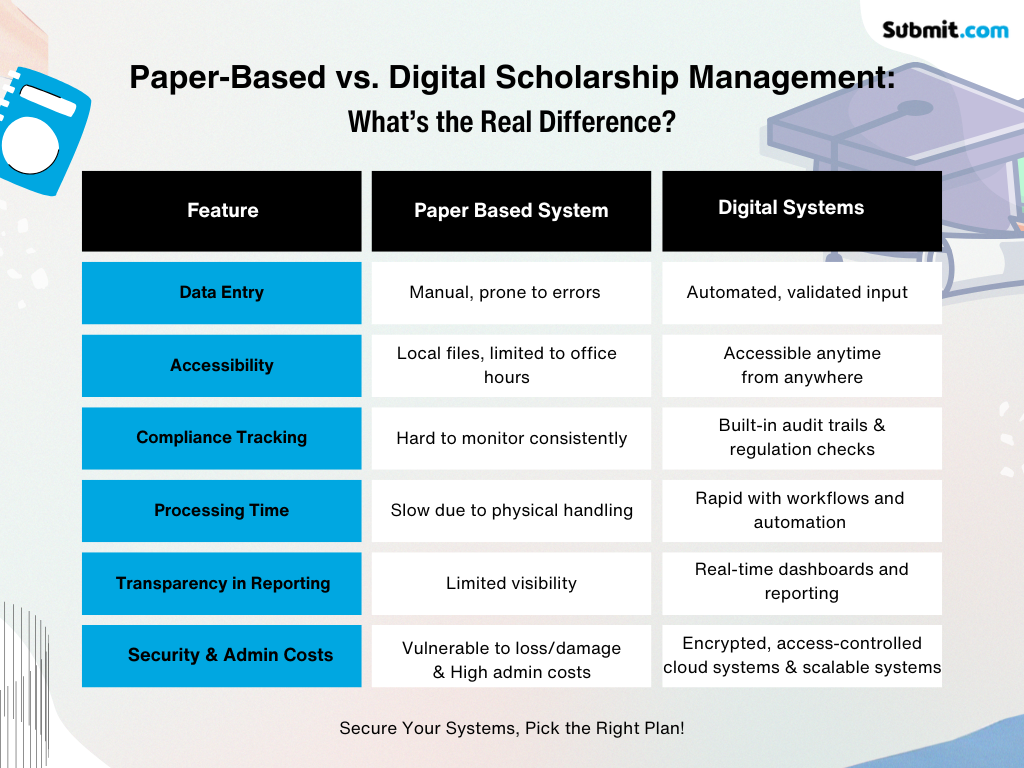
The Impact of Digital Transformation on Scholarship Management
Digital transformation has been a game-changer for scholarship management. It has drastically reduced administrative burdens and enhanced operational efficiency.
The use of sophisticated software allows instant access to records and data analysis tools. This enables quick decision-making and reduces the room for errors.
Such systems enhance transparency and accountability. Grant managers can easily oversee fund distribution and ensure compliance with regulations.
Moreover, they support remote work environments, vital in today’s global landscape. This adaptability ensures that scholarships can be managed from anywhere, at any time.
Key benefits of digital transformation in scholarship management include:
- Robust security features to protect sensitive data and prevent breaches
- Encrypted cloud storage and access control safeguards for stakeholder trust
- Audit-ready records that reinforce compliance and accountability
- Remote accessibility for distributed teams and applicants
Identifying the Challenges in Scholarship Management

Scholarship management systems face several hurdles in their execution. Understanding these challenges is key to improving them.
Inefficiency stems from outdated processes that cannot meet modern demands. Slow data entry and retrieval can delay critical decisions.
Ensuring compliance with regulations remains a persistent challenge. Non-compliance can lead to severe repercussions for organizations.
Scholarship management also struggles with remote readiness. Many systems lack the adaptability required for hybrid or distributed work environments.
Developing a data strategy is another significant challenge. Without a strategic approach, managing scholarship data can become chaotic and fragmented.
User experience and accessibility are often overlooked. Stakeholders need interfaces that are intuitive and easy to navigate across devices.
Overcoming Inefficiency and Outdated Practices
Inefficient scholarship management often results from outdated practices. These systems can impede the timely processing of applications and disbursements.
Digital solutions offer a way forward. By automating routine tasks, these systems reduce errors and speed up processes.
Transitioning to modern systems requires an initial investment. However, the long-term benefits of improved efficiency outweigh these costs.
Training and change management are crucial to this transition. Staff must be equipped to handle new technologies effectively.
Systems should be flexible and scalable to adapt to future needs. This ensures sustainability and continued improvement over time.
Ensuring Compliance and Transparency
Compliance is critical in scholarship management. Organizations must adhere to strict regulations to maintain their credibility.
Digital platforms provide robust compliance features. Automated checks and audit trails help ensure adherence to regulatory requirements.
Transparency is equally essential. Stakeholders need assurance that funds are allocated fairly and responsibly.
Real-time tracking and reporting capabilities foster transparency. This builds trust among stakeholders and reduces potential conflicts.
Continuous monitoring and evaluation processes are vital. This proactive approach mitigates risks and addresses compliance issues promptly.
Facilitating Remote Work and Data Strategy
The need for remote work capabilities in scholarship management is growing. Digital systems make it feasible to manage scholarships from anywhere.
These platforms facilitate communication and collaboration among stakeholders. Integrated tools support seamless workflows regardless of location.
A sound data strategy is also crucial for success. It provides a structured approach to data collection, storage, and analysis—something global education bodies are increasingly advocating for.
“Digital innovation has demonstrated powers to complement, enrich and transform education, and has the potential to speed up progress towards Sustainable Development Goal 4 (SDG 4) for education and transform modes of provision of universal access to learning.” — UNESCO
Data-driven decisions enhance the efficiency of scholarship processes. Organizations can optimize their resources effectively with actionable insights.
Finally, secure data management practices safeguard against breaches. An emphasis on data security ensures compliance with privacy regulations.
The Role of Scholarship Management Software
Scholarship management software is transforming how scholarships are managed. These tools are designed to enhance efficiency and accuracy.
By automating processes, the software reduces the administrative burden. Tasks that took hours now take minutes.
Such systems provide a centralized platform for handling all scholarship tasks. This includes application processing, fund disbursement, and compliance monitoring.
Security and data protection are also pivotal features. They ensure that sensitive information is handled with care.
Overall, scholarship management software supports a more transparent and accountable process. This fosters trust among stakeholders and applicants alike.
Streamlining Decision-Making and Operations
Decision-making is pivotal in scholarship management. Software tools simplify this by offering data-driven insights.
Automation plays a crucial role in operational efficiency. Routine checks and approvals can be executed automatically.
Decisions can be informed by real-time reports generated by the software. This facilitates quicker and more informed choices.
Moreover, streamlined operations mean fewer errors. Reduced redundancy and timely processes enhance the overall management system.
Data-Driven Strategies and Analytics
Data-driven strategies are increasingly important in scholarship management. Software tools provide robust data analytics capabilities.
These systems collect and analyze vast amounts of data. Managers can then base their strategies on concrete insights.
Analytics helps predict trends and optimize fund allocation. Organizations can identify which programs are most effective.
| Manual Decision-Making | Data-Driven Decision-Making |
|---|---|
| Relies on human judgment and paper records | Powered by real-time dashboards and analytics |
| Slow and inconsistent | Fast, repeatable, and transparent |
| Difficult to measure outcomes | Supports forecasting and impact tracking |
Real-time data access enables continuous strategy refinement. This leads to better resource management and long-term operational success.
Enhancing User Experience and Accessibility
Ease of use is essential for any software. User-friendly interfaces ensure that stakeholders can navigate systems effortlessly.
Accessibility involves more than just a pleasant interface. It requires comprehensive features that cater to diverse user needs:
- Dashboards that give quick visibility into tasks and timelines
- Self-service portals that reduce dependency on admin teams
- Role-based access for secure, tailored experiences
- Multilingual or localization support for wider accessibility
- Mobile responsiveness to manage scholarships on the go
Finally, mobile accessibility is no longer optional. Users expect to access their dashboards and documents from any device, anywhere.
Selecting the Best Scholarship Management Software in the UK
Choosing the right scholarship management software is a crucial step toward operational efficiency. The UK market offers a range of sophisticated solutions, but finding one that truly aligns with your organization’s needs requires careful consideration.
Start by evaluating your internal processes and pain points. Every institution is unique, and so are its scholarship programs. Scalability and integration should be top priorities — the ideal software should grow with your needs and fit seamlessly into your existing tech stack.
Security and compliance are also non-negotiables. With data protection laws like GDPR in effect, your software must ensure safe handling of personal information. If you’re unsure whether your current tools meet GDPR requirements, this guide from Submit.com offers actionable advice on GDPR-compliant submissions.
And here’s a compelling stat to keep in mind: Over £150 million worth of scholarships are available to UK students every year, yet many go unclaimed due to administrative barriers or poor visibility. [Source] The right software can help bridge that gap — by simplifying applications, automating workflows, and offering better reporting.
Support and training are key during implementation. Choose providers who not only offer reliable tech but also stand by you with dedicated onboarding and ongoing help.
Here’s a checklist to streamline your selection process:
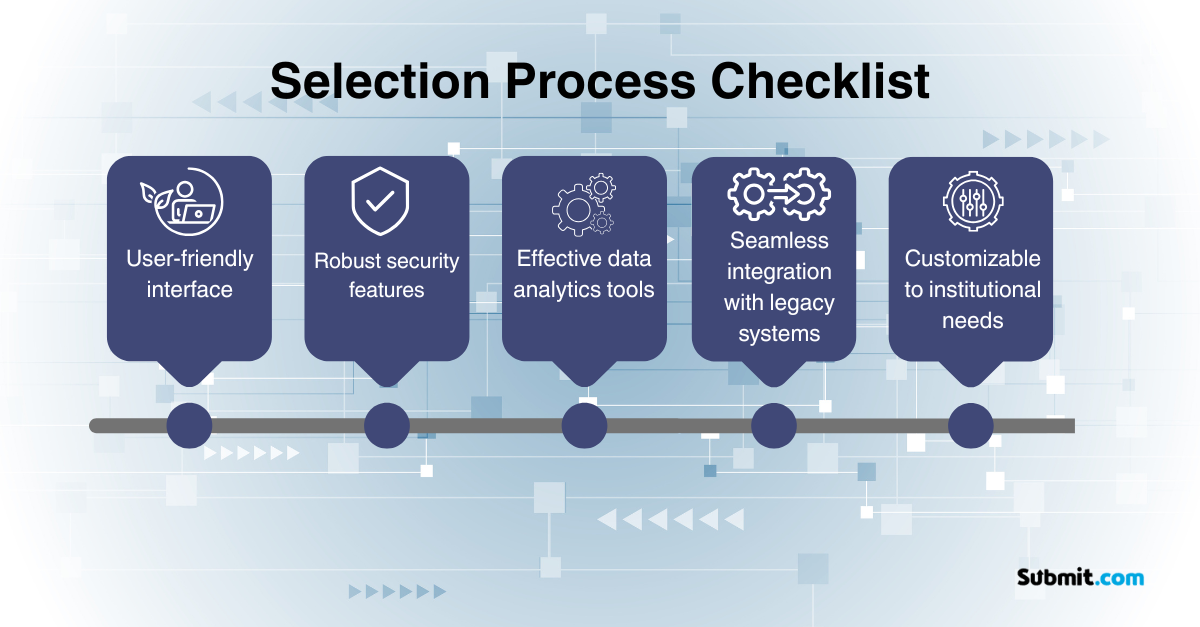
Key Features to Look For
1) Prioritize usability. A clean, intuitive interface reduces the learning curve for administrators and applicants alike.
2) Customizability matters. Every scholarship program is different — your software should be flexible enough to adapt to varied workflows, eligibility criteria, and fund management rules.
3) Data analytics capabilities are now a must-have. The ability to track application trends, monitor fund utilization, and generate reports is key for both performance tracking and strategic planning.
4) GDPR compliance should be built in from day one. Data security isn’t just about encryption — it’s about having the right permissions, retention policies, and audit trails in place.
Lastly, ensure the platform can integrate easily with your existing tools — whether it’s a CRM, payment processor, or student database.
Addressing the Pain Points of Stakeholders
Managing scholarships in the public sector involves diverse stakeholders, each with unique pain points. Addressing these issues is crucial for effective scholarship management.
Government grant managers often grapple with outdated processes. These hinder fast decision-making and lead to compliance concerns.
For IT strategists, identifying suitable software solutions that support remote work and data strategies can be daunting. They need systems that integrate well with existing infrastructure.
Digital transformation consultants face their own hurdles. Convincing organizations of digital benefits and ensuring seamless technology adoption is challenging.
Understanding these pain points allows tailored solutions to be implemented. The right approach can lead to significant improvements across processes, compliance, and overall efficiency.
Government Grant Managers’ Perspective
Government grant managers often face inefficiency. Manual processes consume time and introduce errors into scholarship management.
They also have to ensure compliance with regulations. Non-compliance can result in severe penalties and loss of funding.
A major concern is the lack of visibility over funds. This can lead to delays in fund disbursement and applicant dissatisfaction.
Digital transformation promises solutions. Automation and better tracking systems can significantly enhance management and compliance.
Public Sector IT Strategists’ Viewpoint
IT strategists in the public sector are tasked with modernizing infrastructure. They must ensure that systems are remote-friendly and resilient.
A core challenge is data management. They seek solutions that can handle vast amounts of data securely and efficiently.
Another area of focus is integration. New systems must synchronize with existing ones for seamless operations.
Finally, security cannot be overlooked. Protecting sensitive scholarship data is paramount in today’s digital age.
Insights for Digital Transformation Consultants
Digital transformation consultants must advocate for technology adoption. They play a crucial role in transitioning organizations to digital systems.
Resistance to change is a common barrier. Consultants need to demonstrate the tangible benefits of digital transformation.
Ensuring user adoption is another hurdle. Training and support are critical for smooth implementation.
Consultants should also focus on scalability. The solutions they recommend must accommodate future growth and advancements.
The Future of Scholarship Management Systems
The evolution of scholarship management systems is accelerating. This evolution is driven by technological advances and changing user needs.
Future systems will emphasize user-centric approaches. They will cater to diverse user bases, enhancing satisfaction and engagement.
Integration will play a crucial role. Systems must connect seamlessly with other educational and governmental platforms.
The demand for real-time data access will rise. This change facilitates quicker decision-making and better resource allocation.
Security will remain a key focus. Protecting sensitive data must be a core feature of any future-ready management system.
Embracing Innovation and AI
AI is transforming scholarship management. It offers opportunities for efficiency and personalization never seen before.
Automated application processing can significantly reduce workload. AI can sift through applications at lightning speed, identifying eligible candidates.
Personalization is enhanced through AI-driven insights. Systems can tailor notifications and opportunities to individual needs and preferences.
Machine learning can predict trends. Understanding these patterns helps in planning and optimizing scholarship fund allocation.
The Role of Continuous Improvement and Training
Continuous improvement is vital for maintaining effective systems. Keeping software and processes updated ensures they meet current needs.
Training is crucial to this process. It empowers users to utilize systems to their fullest potential.
Ongoing training helps overcome resistance to new technology. It builds confidence and encourages adoption among all users.
Furthermore, gathering feedback must be a regular practice. Insights from end-users drive improvements, ensuring systems remain relevant and effective.
Preparing for the Next Wave of Digital Transformation
The digital landscape is ever-evolving. Staying ahead requires adaptability and strategic foresight.
Organizations must embrace a culture of continuous learning. Staying informed about new technologies fosters a proactive approach to change.
Building partnerships with tech vendors can provide a competitive edge. These partnerships offer early access to innovations and collaborative development opportunities.
Finally, flexibility will be crucial. Systems should be designed with adaptability in mind, ready to evolve with emerging technological trends.
Conclusion: The Strategic Path Forward
Navigating the challenges in scholarship management requires strategic thought. Digital transformation offers promising solutions to improve efficiency and transparency.
Aligning with best practices is essential. It ensures systems are not only current but also future-ready for technological advances.
A strategic approach integrates user needs, technological capability, and regulatory compliance. This integration fosters a robust and adaptable management system.
In conclusion, embracing innovation, guided by informed decision-making and strategic planning, will lead to more successful scholarship management. The shift to digital platforms can significantly enhance visibility, expedite processes, and ensure compliance, paving the way for a more efficient and inclusive future.
Modernize Your Scholarship Management—Without the Paper Trails
See how Submit.com helps public sector teams and education providers save time, improve compliance, and streamline decision-making—all in one secure platform.
📅 Book a Free Demo
